Application of Dynamic Programming Models for Improvement of Technological Approaches to Combat Negative Water Leakage in the Underground Space
Abstract
:1. Introduction
2. Materials and Methods
2.1. Study Area
- The optimal solution: dynamic programming usually provides an optimal solution to a problem.
- Dynamic programming has certain limitations.
- Dependence on the structure of the problem: to use dynamic programming, the problem must have an optimal structure, which may not always be achieved.
- The need for a large amount of memory: the memorisation of results can require a significant amount of memory, especially for large problems.
2.2. Dynamic Programming Model
- -
- When the process is multi-stage and all stages are interconnected;
- -
- when the process is time-consuming;
- -
- when the efficiency of the process is influenced not only by quantitative but also by qualitative indicators.
- τ—an arbitrary parameter;
- y—is an arbitrary vector.
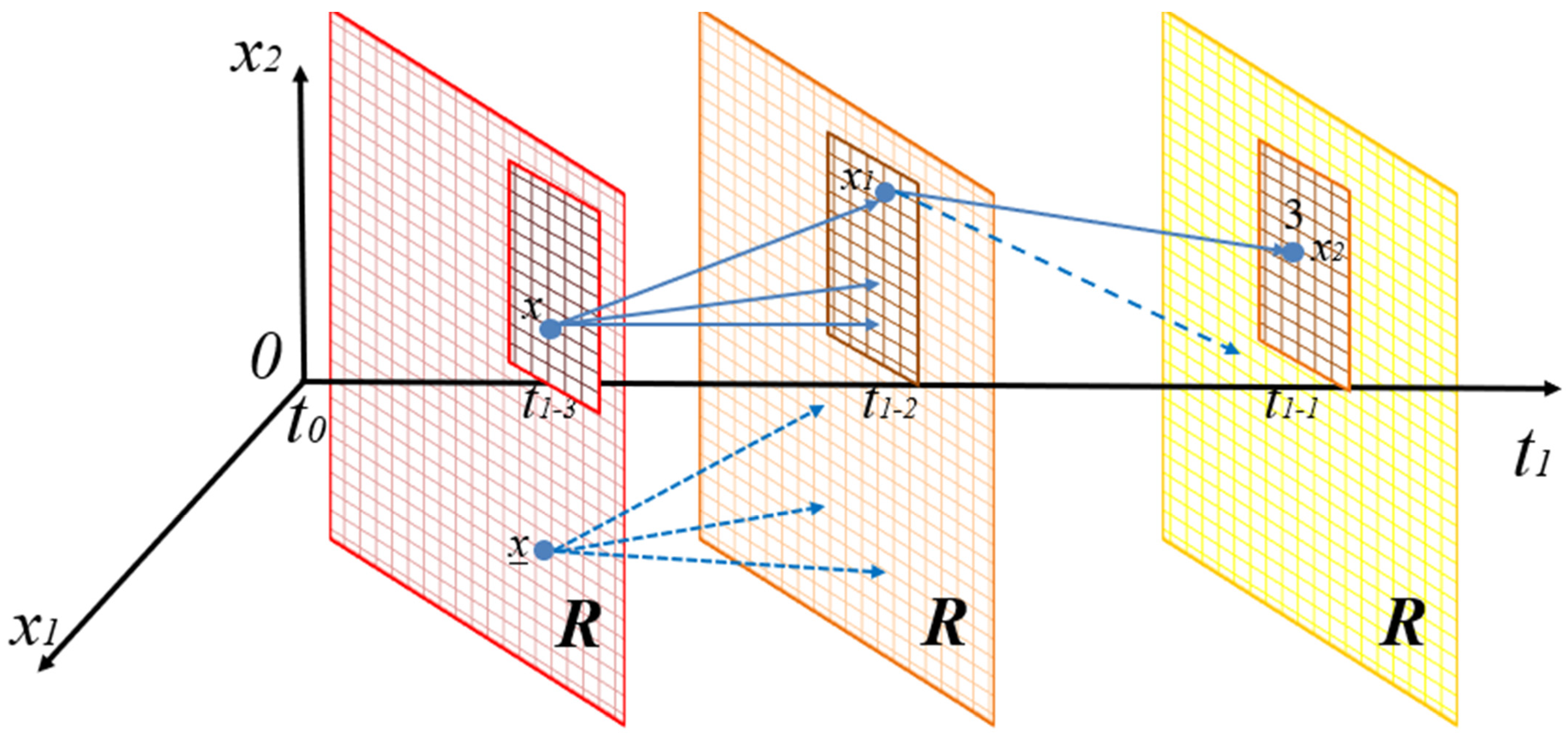
2.3. The Development of a Model for Finding an Optimal Technological Solution in Complex Hydrogeological Conditions
3. Results
3.1. Systematisation of the Stages of Construction of Support to Combat Negative Water Leakage: Basic Model
3.2. Model for Finding Optimal Technological Solutions to Combat Water Inflows in Difficult Hydrogeological Conditions
4. Discussion
5. Conclusions
Author Contributions
Funding
Data Availability Statement
Conflicts of Interest
References
- Nate, S.; Bilan, Y.; Cherevatskyi, D.; Kharlamova, G.; Lyakh, O.; Wosiak, A. The Impact of Energy Consumption on the Three Pillars of Sustainable Development. Energies 2021, 14, 1372. [Google Scholar] [CrossRef]
- Hrinov, V.; Khorolskyi, A. Improving the Process of Coal Extraction Based on the Parameter Optimization of Mining Equipment. E3S Web Conf. 2018, 60, 00017. [Google Scholar] [CrossRef]
- Shepherd, N.G.; Rudd, J.M. The Influence of Context on the Strategic Decision-Making Process: A Review of the Literature. Int. J. Manag. Rev. 2014, 16, 340–364. [Google Scholar] [CrossRef]
- Stankevich, A. Explaining the Consumer Decision-Making Process: Critical Literature Review. J. Int. Bus. Res. Mark. 2017, 2, 7–14. [Google Scholar] [CrossRef]
- Khorolskyi, A.; Hrinov, V.; Mamaikin, O.; Demchenko, Y. Models and Methods to Make Decisions While Mining Production Scheduling. Min. Miner. Depos. 2019, 13, 53–62. [Google Scholar] [CrossRef]
- Li, X.; Chen, G.; Dong, Z.Y. Co-optimisation Model for the Long-term Design and Decision Making in Community Level Cloud Energy Storage System. IET Renew. Power Gener. 2020, 14, 3518–3525. [Google Scholar] [CrossRef]
- Huang, S.; Li, G.; Ben-Awuah, E.; Afum, B.O.; Hu, N. A Robust Mixed Integer Linear Programming Framework for Underground Cut-and-Fill Mining Production Scheduling. Int. J. Min. Reclam. Environ. 2020, 34, 397–414. [Google Scholar] [CrossRef]
- Gill, P.E.; Wong, E. Methods for Convex and General Quadratic Programming. Math. Prog. Comp. 2015, 7, 71–112. [Google Scholar] [CrossRef]
- Little, J.; Topal, E. Strategies to Assist in Obtaining an Optimal Solution for an Underground Mine Planning Problem Using Mixed Integer Programming. Int. J. Min. Miner. Eng. 2011, 3, 152. [Google Scholar] [CrossRef]
- MacNeil, J.A.L.; Dimitrakopoulos, R.G. A Stochastic Optimization Formulation for the Transition from Open Pit to Underground Mining. Optim. Eng. 2017, 18, 793–813. [Google Scholar] [CrossRef]
- Khorolskyi, A.; Hrinov, V.; Kaliushenko, O. Network Models for Searching for Optimal Economic and Environmental Strategies for Field Development. Procedia Environ. Sci. Eng. Manag. 2019, 6, 463–471. [Google Scholar]
- Balezentis, T.; Streimikiene, D.; Siksnelyte-Butkiene, I. Energy Storage Selection for Sustainable Energy Development: The Multi-Criteria Utility Analysis Based on the Ideal Solutions and Integer Geometric Programming for Coordination Degree. Environ. Impact Assess. Rev. 2021, 91, 106675. [Google Scholar] [CrossRef]
- Hill, A.; Brickey, A.J.; Cipriano, I.; Goycoolea, M.; Newman, A. Optimization Strategies for Resource-Constrained Project Scheduling Problems in Underground Mining. INFORMS J. Comput. 2022, 34, 3042–3058. [Google Scholar] [CrossRef]
- Özyurt, M.C.; Karadogan, A. A New Model Based on Artificial Neural Networks and Game Theory for the Selection of Underground Mining Method. J. Min. Sci. 2020, 56, 66–78. [Google Scholar] [CrossRef]
- Khorolskyi, A.; Hrinov, V.; Mamaikin, O.; Fomychova, L. Research into Optimization Model for Balancing the Technological Flows at Mining Enterprises. E3S Web Conf. 2020, 201, 01030. [Google Scholar] [CrossRef]
- Petlovanyi, M.; Sai, K.; Malashkevych, D.; Popovych, V.; Khorolskyi, A. Influence of Waste Rock Dump Placement on the Geomechanical State of Underground Mine Workings. IOP Conf. Ser. Earth Environ. Sci. 2023, 1156, 012007. [Google Scholar] [CrossRef]
- Kwinta, A.; Gradka, R. Analysis of the Damage Influence Range Generated by Underground Mining. Int. J. Rock Mech. Min. Sci. 2020, 128, 104263. [Google Scholar] [CrossRef]
- Vayenas, N.; Peng, S. Reliability Analysis of Underground Mining Equipment Using Genetic Algorithms: A Case Study of Two Mine Hoists. J. Qual. Maint. Eng. 2014, 20, 32–50. [Google Scholar] [CrossRef]
- Thoft-Christensen, P.; Murotsu, Y. Application of Structural Systems Reliability Theory; Springer Science & Business Media: Berlin/Heidelberg, Germany, 2012. [Google Scholar]
- Petropoulos, F.; Apiletti, D.; Assimakopoulos, V.; Babai, M.Z.; Barrow, D.K.; Ben Taieb, S.; Bergmeir, C.; Bessa, R.J.; Bijak, J.; Boylan, J.E.; et al. Forecasting: Theory and Practice. Int. J. Forecast. 2022, 38, 705–871. [Google Scholar] [CrossRef]
- Tsai, S.-B.; Xue, Y.; Zhang, J.; Chen, Q.; Liu, Y.; Zhou, J.; Dong, W. Models for Forecasting Growth Trends in Renewable Energy. Renew. Sustain. Energy Rev. 2017, 77, 1169–1178. [Google Scholar] [CrossRef]
- Daganzo, C. Multinomial Probit: The Theory and Its Application to Demand Forecasting; Elsevier: Amsterdam, The Netherlands, 2014. [Google Scholar]
- Lousada, S.A.N. Hydraulics: Theory—Volume I; Universidade Da Madeira: Funchal, Portugal, 2018; p. 348. ISBN 978-989-8805-48-5. [Google Scholar]
- Lane, S.N. Natural Flood Management. WIREs Water 2017, 4, e1211. [Google Scholar] [CrossRef]
- Blagojević, B.; Vasilevska, L.; Anđelković, D.; Bogojević, A.; Lousada, S. A Framework for Assessing Nature-Based Urban Stormwater Management Solutions: A Preliminary Spatial Analysis Approach Applied to Southeast Serbia. Water 2023, 15, 3604. [Google Scholar] [CrossRef]
- Jenkins, K.; Surminski, S.; Hall, J.; Crick, F. Assessing Surface Water Flood Risk and Management Strategies under Future Climate Change: Insights from an Agent-Based Model. Sci. Total Environ. 2017, 595, 159–168. [Google Scholar] [CrossRef] [PubMed]
- Lousada, S. Geoinformatics in Support of Urban Politics and the Development of Civil Engineering; IGI Global: Hershey, PA, USA, 2023. [Google Scholar]
- Li, W.; De Vriend, H.J.; Wang, Z.; Van Maren, D.S. Morphological Modeling Using a Fully Coupled, Total Variation Diminishing Upwind-Biased Centered Scheme: Efficient and Accurate Coupled Morphological Modeling. Water Resour. Res. 2013, 49, 3547–3565. [Google Scholar] [CrossRef]
- Le, M.-H.; Cordier, S.; Lucas, C.; Cerdan, O. A Faster Numerical Scheme for a Coupled System Modeling Soil Erosion and Sediment Transport. Water Resour. Res. 2015, 51, 987–1005. [Google Scholar] [CrossRef]
- Gunantara, N. A Review of Multi-Objective Optimization: Methods and Its Applications. Cogent Eng. 2018, 5, 1502242. [Google Scholar] [CrossRef]
- Bottou, L.; Curtis, F.E.; Nocedal, J. Optimization Methods for Large-Scale Machine Learning. SIAM Rev. 2018, 60, 223–311. [Google Scholar] [CrossRef]
- Ball, M.O. Heuristics Based on Mathematical Programming. Surv. Oper. Res. Manag. Sci. 2011, 16, 21–38. [Google Scholar] [CrossRef]
- Pishvaee, M.S.; Khalaf, M.F. Novel Robust Fuzzy Mathematical Programming Methods. Appl. Math. Model. 2016, 40, 407–418. [Google Scholar] [CrossRef]
- Grossmann, I.E. Advances in Mathematical Programming Models for Enterprise-Wide Optimization. Comput. Chem. Eng. 2012, 47, 2–18. [Google Scholar] [CrossRef]
- Xu, G.; Wan, S.; Wang, F.; Dong, J.; Zeng, Y. Mathematical Programming Methods for Consistency and Consensus in Group Decision Making with Intuitionistic Fuzzy Preference Relations. Knowl.-Based Syst. 2016, 98, 30–43. [Google Scholar] [CrossRef]
- Herskovits, J.; Mappa, P.; Goulart, E.; Mota Soares, C.M. Mathematical Programming Models and Algorithms for Engineering Design Optimization. Comput. Methods Appl. Mech. Eng. 2005, 194, 3244–3268. [Google Scholar] [CrossRef]
- D’Ambrosio, C.; Lodi, A.; Wiese, S.; Bragalli, C. Mathematical Programming Techniques in Water Network Optimization. Eur. J. Oper. Res. 2015, 243, 774–788. [Google Scholar] [CrossRef]
- Yang, L.; Liu, S.; Tsoka, S.; Papageorgiou, L.G. Mathematical Programming for Piecewise Linear Regression Analysis. Expert Syst. Appl. 2016, 44, 156–167. [Google Scholar] [CrossRef]
- Saaty, T.L.; Vargas, L.G. The Analytic Network Process. In Decision Making with the Analytic Network Process; International Series in Operations Research & Management Science; Springer: Boston, MA, USA, 2013; Volume 195, pp. 1–40. [Google Scholar] [CrossRef]
- Brans, J.-P.; De Smet, Y. PROMETHEE Methods. In Multiple Criteria Decision Analysis; Greco, S., Ehrgott, M., Figueira, J.R., Eds.; International Series in Operations Research & Management Science; Springer: New York, NY, USA, 2016; Volume 233, pp. 187–219. [Google Scholar] [CrossRef]
- Corrente, S.; Figueira, J.R.; Greco, S. The SMAA-PROMETHEE Method. Eur. J. Oper. Res. 2014, 239, 514–522. [Google Scholar] [CrossRef]
- Singh, A.; Gupta, A.; Mehra, A. Best Criteria Selection Based PROMETHEE II Method. Opsearch 2021, 58, 160–180. [Google Scholar] [CrossRef]
- Ishizaka, A.; Nemery, P. Selecting the Best Statistical Distribution with PROMETHEE and GAIA. Comput. Ind. Eng. 2011, 61, 958–969. [Google Scholar] [CrossRef]
- Figueira, J.R.; Mousseau, V.; Roy, B. ELECTRE Methods. In Multiple Criteria Decision Analysis; Greco, S., Ehrgott, M., Figueira, J.R., Eds.; International Series in Operations Research & Management Science; Springer: New York, NY, USA, 2016; Volume 233, pp. 155–185. [Google Scholar] [CrossRef]
- Llamazares, B. An Analysis of the Generalized TODIM Method. Eur. J. Oper. Res. 2018, 269, 1041–1049. [Google Scholar] [CrossRef]
- Alali, F.; Tolga, A.C. Portfolio Allocation with the TODIM Method. Expert Syst. Appl. 2019, 124, 341–348. [Google Scholar] [CrossRef]
- Taherdoost, H.; Madanchian, M. An Effective Compromising Ranking Technique for Decision Making. Macro Manag. Public Policies 2023, 5, 27–33. [Google Scholar] [CrossRef]
- Ayağ, Z.; Özdemir, R.G. A Fuzzy AHP Approach to Evaluating Machine Tool Alternatives. J. Intell. Manuf. 2006, 17, 179–190. [Google Scholar] [CrossRef]
- Srdjevic, B.; Medeiros, Y.D.P. Fuzzy AHP Assessment of Water Management Plans. Water Resour. Manag. 2008, 22, 877–894. [Google Scholar] [CrossRef]
- Sahoo, S.; Dhar, A.; Kar, A. Environmental Vulnerability Assessment Using Grey Analytic Hierarchy Process Based Model. Environ. Impact Assess. Rev. 2016, 56, 145–154. [Google Scholar] [CrossRef]
- Roozbahani, A.; Ghased, H.; Shahedany, M.H. Inter-Basin Water Transfer Planning with Grey COPRAS and Fuzzy COPRAS Techniques: A Case Study in Iranian Central Plateau. Sci. Total Environ. 2020, 726, 138499. [Google Scholar] [CrossRef]
- Liu, Y.; Wang, C.; Chun, Y.; Yang, L.; Chen, W.; Ding, J. A Novel Method in Surface Water Quality Assessment Based on Improved Variable Fuzzy Set Pair Analysis. Int. J. Environ. Res. Public Health 2019, 16, 4314. [Google Scholar] [CrossRef]
- Yan, F.; Liu, L.; Zhang, Y.; Chen, M.; Chen, N. The Research of Dynamic Variable Fuzzy Set Assessment Model in Water Quality Evaluation. Water Resour. Manag. 2016, 30, 63–78. [Google Scholar] [CrossRef]
- Saaty, T.L. Decision Making with the Analytic Hierarchy Process. Int. J. Serv. Sci. 2008, 1, 83. [Google Scholar] [CrossRef]
- Bildirici, M.E.; Lousada, S.; Yılmaz Genç, S. Terrorism, Freshwater, and Environmental Pollution: Evidence of Afghanistan, Burkina Faso, Iraq, Arab Republic of Egypt, Cameroon, Mali, Mozambique, Niger, Nigeria, Somalia, Syrian Arab Republic, and Pakistan. Water 2022, 14, 2684. [Google Scholar] [CrossRef]
- Lousada, S.A.N. Hydrology, Water Resources and Environment: Theorical Classes; Universidade Da Madeira: Funchal, Portugal, 2019; pp. 1–220. [Google Scholar]
- Paravarzar, S.; Pourrahimian, Y.; Nasab, H.A.; Emery, X. Short-Term Underground Mine Planning: A Review. Int. J. Min. Miner. Eng. 2021, 12, 1. [Google Scholar] [CrossRef]
- Wang, K.; Davies, E.G.R. Municipal Water Planning and Management with an End-Use Based Simulation Model. Environ. Model. Softw. 2018, 101, 204–217. [Google Scholar] [CrossRef]
- Babamiri, O.; Marofi, S. A Multi-Objective Simulation–Optimization Approach for Water Resource Planning of Reservoir–River Systems Based on a Coupled Quantity–Quality Model. Environ. Earth Sci. 2021, 80, 389. [Google Scholar] [CrossRef]
- Singh, A. Simulation–Optimization Modeling for Conjunctive Water Use Management. Agric. Water Manag. 2014, 141, 23–29. [Google Scholar] [CrossRef]
- Grundmann, J.; Schütze, N.; Schmitz, G.H.; Al-Shaqsi, S. Towards an Integrated Arid Zone Water Management Using Simulation-Based Optimisation. Environ. Earth Sci. 2012, 65, 1381–1394. [Google Scholar] [CrossRef]
- Reinhart, R.; Dang, T.; Hand, E.; Papachristos, C.; Alexis, K. Learning-Based Path Planning for Autonomous Exploration of Subterranean Environments. In Proceedings of the 2020 IEEE International Conference on Robotics and Automation (ICRA), Paris, France, 31 May–31 August 2020; pp. 1215–1221. [Google Scholar] [CrossRef]
- Li, S.; Huang, Q.; Hu, B.; Pan, J.; Chen, J.; Yang, J.; Zhou, X.; Wang, X.; Yu, H. Mining Method Optimization of Difficult-to-Mine Complicated Orebody Using Pythagorean Fuzzy Sets and TOPSIS Method. Sustainability 2023, 15, 3692. [Google Scholar] [CrossRef]
- Emdini Gliwan, S.; Crowe, K. A Network Flow Model for Operational Planning in an Underground Gold Mine. Mining 2022, 2, 712–724. [Google Scholar] [CrossRef]
- Fazlali, A.; Shourian, M. A Demand Management Based Crop and Irrigation Planning Using the Simulation-Optimization Approach. Water Resour. Manag. 2018, 32, 67–81. [Google Scholar] [CrossRef]
- Delehan, S.; Melehanych, H.; Khorolskyi, A. The Traditions and Technologies of Ecological Construction in Portugal. In Proceedings of the 4th International Conference on Advances in Environmental Engineering, Ostrava, Czech Republic, 20–22 November 2023; MDPI: Basel, Switzerland, 2023; p. 23. [Google Scholar] [CrossRef]
- Bhatt, D.; Mall, R.K. Surface Water Resources, Climate Change and Simulation Modeling. Aquat. Procedia 2015, 4, 730–738. [Google Scholar] [CrossRef]
- Soleimanian, E.; Afshar, A.; Molajou, A. A Review on Water Simulation Models for the WEF Nexus: Development Perspective. Environ. Sci. Pollut. Res. 2022, 29, 79769–79785. [Google Scholar] [CrossRef] [PubMed]
- Salli, S.; Pochepov, V.; Mamaykin, O. Theoretical Aspects of the Potential Technological Schemes Evaluation and Their Susceptibility to Innovations. In Progressive Technologies of Coal, Coalbed Methane, and Ores Mining; CRC Press: London, UK, 2014; pp. 479–484. [Google Scholar] [CrossRef]
- Guo, D.; Hou, H.; Long, J.; Guo, X.; Xu, H. Underestimated Environmental Benefits of Tailings Resource Utilization: Evidence from a Life Cycle Perspective. Environ. Impact Assess. Rev. 2022, 96, 106832. [Google Scholar] [CrossRef]
- Eddy, S.R. What Is Dynamic Programming? Nat. Biotechnol. 2004, 22, 909–910. [Google Scholar] [CrossRef]
- Fu, M.; Liu, S.; Jia, H.; He, D. Experimental Study of an Orientation and Resin-Lifting Device for Improving the Performance of Resin-Anchored Roof Bolts. Rock Mech. Rock Eng. 2020, 53, 211–231. [Google Scholar] [CrossRef]
- Bondarenko, V.I.; Kovalevska, I.A.; Symanovych, H.A.; Sachko, R.M.; Sheka, I.V. Integrated Research into the Stress-Strain State Anomalies, Formed and Developed in the Mass under Conditions of High Advance Velocities of Stope Faces. IOP Conf. Ser. Earth Environ. Sci. 2023, 1254, 012062. [Google Scholar] [CrossRef]
- Bondarenko, V.I.; Kovalevska, I.A.; Podkopaiev, S.V.; Sheka, I.V.; Tsivka, Y.S. Substantiating Arched Support Made of Composite Materials (Carbon Fiber-Reinforced Plastic) for Mine Workings in Coal Mines. IOP Conf. Ser. Earth Environ. Sci. 2022, 1049, 012026. [Google Scholar] [CrossRef]
- Bellman, R.E. Dynamic Programming; Princeton University Press: Princeton, NJ, USA, 2010. [Google Scholar] [CrossRef]
- He, G.; Zhang, X.; Sun, Y.; Luo, G.; Chen, L. Contour Line Simplification Method Based on the Two-level Bellman–Ford Algorithm. Trans. GIS 2021, 25, 396–423. [Google Scholar] [CrossRef]
- Hemalatha, S.; Valsalal, P. Identification of Optimal Path in Power System Network Using Bellman Ford Algorithm. Model. Simul. Eng. 2012, 2012, 913485. [Google Scholar] [CrossRef]
- Małkowski, P.; Niedbalski, Z.; Majcherczyk, T.; Bednarek, Ł. Underground Monitoring as the Best Way of Roadways Support Design Validation in a Long Time Period. Min. Miner. Depos. 2020, 14, 1–14. [Google Scholar] [CrossRef]
- Krukovskyi, O.; Bulich, Y.; Kurnosov, S.; Yanzhula, O.; Demin, V. Substantiating the Parameters for Selecting a Pillar Width to Protect Permanent Mine Workings at Great Depths. IOP Conf. Ser. Earth Environ. Sci. 2022, 970, 012049. [Google Scholar] [CrossRef]
- Małkowski, P.; Niedbalski, Z.; Balarabe, T. A Statistical Analysis of Geomechanical Data and Its Effect on Rock Mass Numerical Modeling: A Case Study. Int. J. Coal Sci. Technol. 2021, 8, 312–323. [Google Scholar] [CrossRef]
- Sdvyzhkova, O.; Patyńska, R. Effect of Increasing Mining Rate on Longwall Coal Mining—Western Donbass Case Study. Stud. Geotech. Mech. 2016, 38, 91–98. [Google Scholar] [CrossRef]
- Skipochka, S.; Krukovskyi, O.; Palamarchuk, T.; Prokhorets, L. On the Methodology for Considering Scale Effect of Rock Strength. Min. Miner. Depos. 2020, 14, 24–30. [Google Scholar] [CrossRef]
- Kochmar, I.; Karabyn, V. Water Extracts from Waste Rocks of the Coal Industry of Chernvonograd Mining Area (Ukraine): Problems of Environmental Safety and Civil Protection. Ecol. Eng. Environ. Technol. 2023, 24, 247–255. [Google Scholar] [CrossRef]
- Huang, Z.; Cheng, Y.; Zhang, D.; Yan, D.; Shen, Y. Seismic Fragility and Resilience Assessment of Shallowly Buried Large-Section Underground Civil Defense Structure in Soft Soils: Framework and Application. Tunn. Undergr. Space Technol. 2024, 146, 105640. [Google Scholar] [CrossRef]
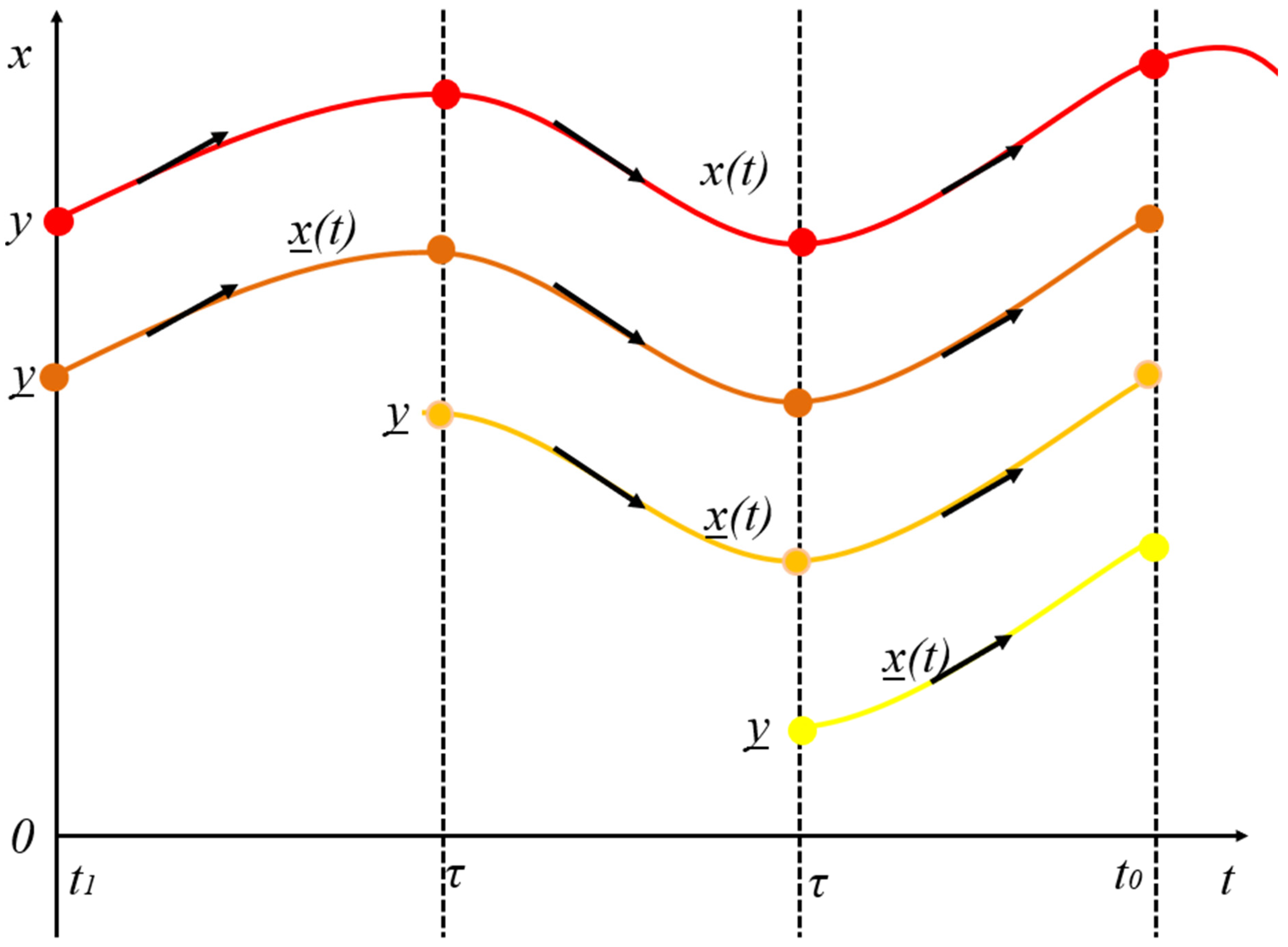

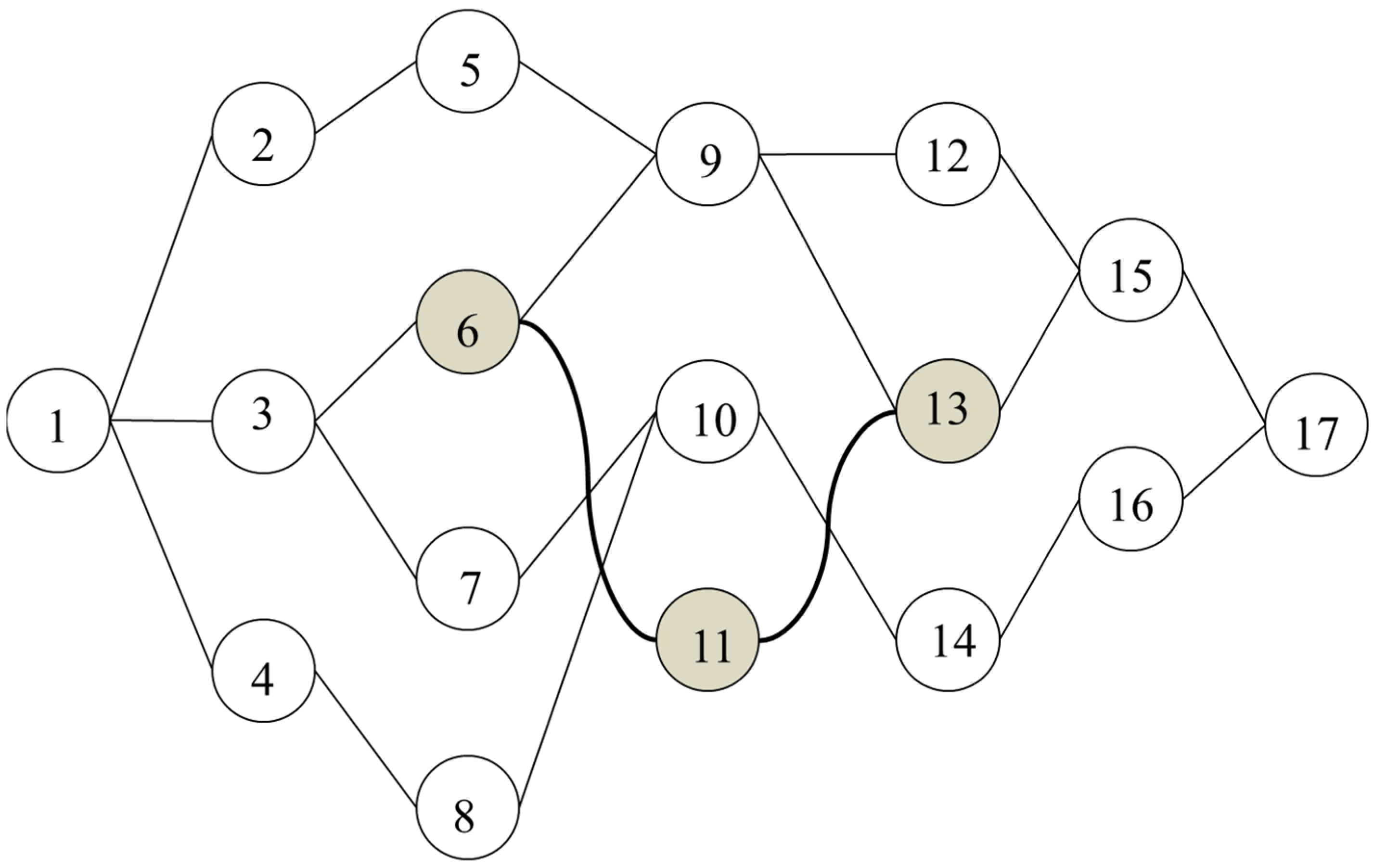
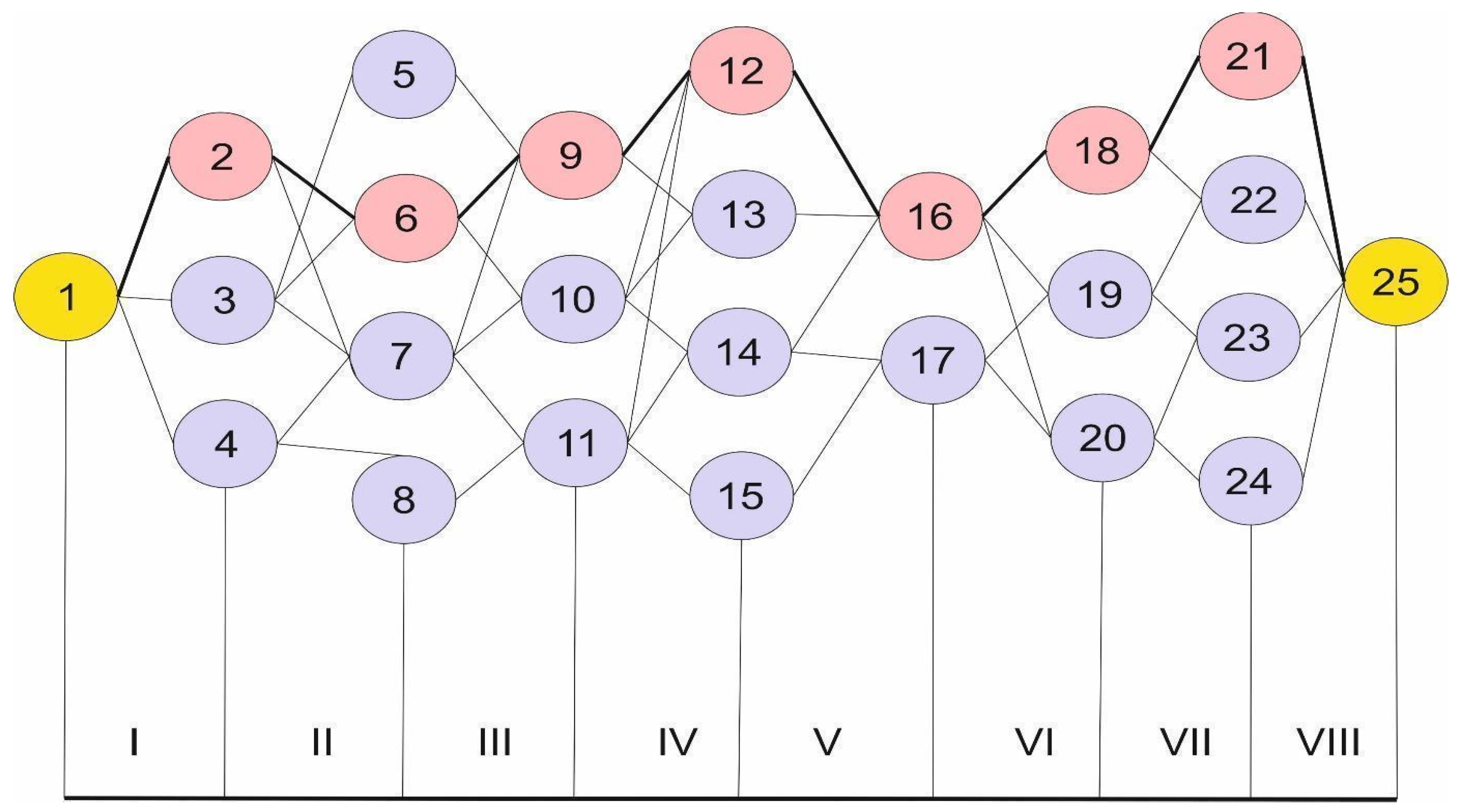


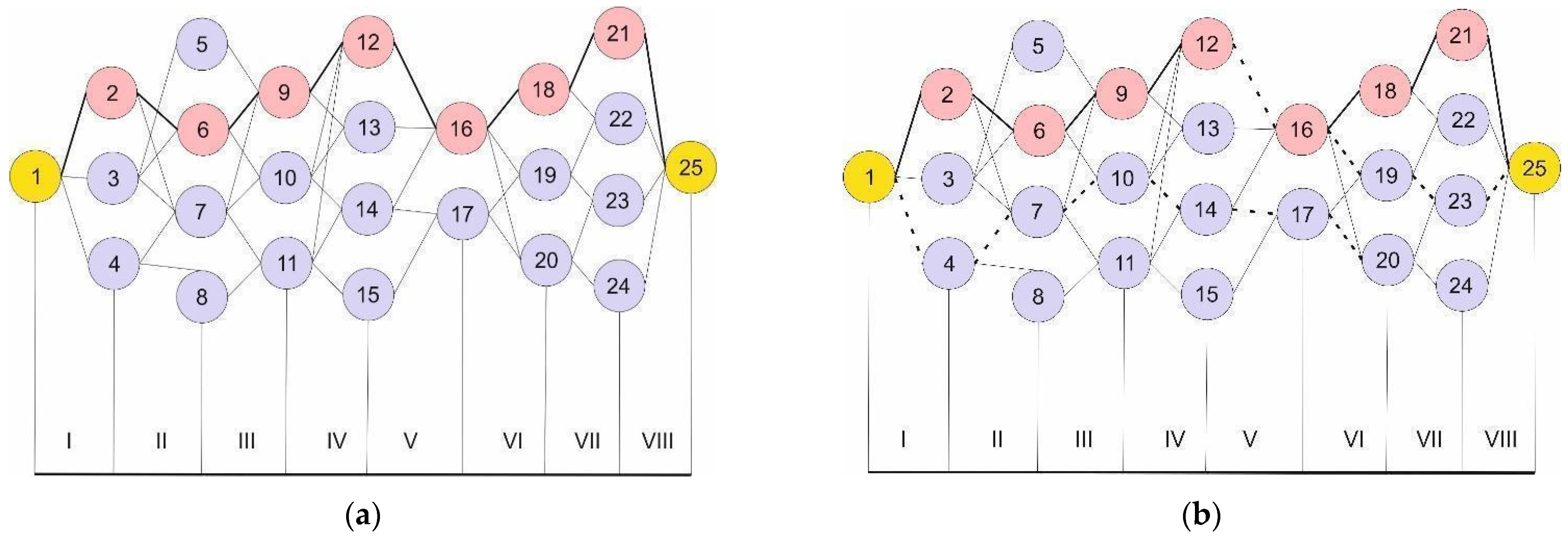

| Negative Impact of Groundwater | Hydrogeological Factor | Technological Factor and Risk |
|---|---|---|
| reduced productivity | specific water inflow | reduced equipment performance |
| the degree of watering of rocks and water permeability | increased construction time and costs | |
| groundwater head, aquifer thickness, water permeability | flooding of workings, additional costs for drainage | |
| reduced stability of products | filtration, degree of water saturation | additional costs for the support of the workings, measures to combat the heaving of the sole of the workings |
| reduced labour safety | water inflow, water permeability, filtration | destruction of temporary or permanent fasteners |
| deterioration in the operation of transport equipment | water saturation | complicated transport of materials, increased construction time |
| Cost Component of the Total Cost | Construction and Operation Phase | Risks Associated with Water Inflows |
|---|---|---|
| materials from which the fasteners will be made to prevent water leakage | initial stage | None |
| transport and warehousing costs | loading, transport and unloading of fasteners | are present, it is necessary to take into account water permeability |
| tools, time costs | preparatory stages (drilling holes for anchors, etc.), transport of materials | are present, it is necessary to have an idea of the thickness of the aquifers of the massif |
| materials, labour intensity | construction of temporary support | are present, it is necessary to analyse the filtering |
| maintenance costs, labour intensity | construction of a permanent support and further operation | are present, the water inflow into the workings is analysed |
| Stage | Stage Name | Objectives | The Essence of the Task Solution |
|---|---|---|---|
| I | organisation of loading and unloading operations on the surface | build a rational structure of the cycle for the organisation of surface loading operations | a balance should be found between resource flows to speed up cargo operations |
| II | delivery of fastening materials in the underground space, taking into account the cost of storing materials in the underground space | a rational structure of the transport chain should be built with the condition of maximum preservation of the quality and quantity of materials for the construction of workings | a balance should be struck between transport operations, suppliers (warehouses) and delivery to the site of construction |
| III | carrying out preparatory work required for the construction of temporary support (drilling holes, constructing grooves, stripping, etc.) | minimising time spent on preparatory operations and reducing costs | it is necessary to select drilling, assembly and loading equipment for these operations |
| IV | erection of a temporary fixture | organisation of the technology for the construction of workings and temporary consolidation of the excavated space | organisation of work on securing the excavated space. main requirements: ease of dismantling, minimisation of the amount of fastening materials, possibility of removing waste generated as a result of previous operations (I–III) |
| V | carrying out work on the construction of a permanent support | minimisation of the amount of materials required to securely fix the produced space | organisation of works on the construction of permanent support. it is necessary to minimise equipment downtime and reduce the consumption of fastening materials. at the same time, it is necessary to ensure the appropriate reliability of the support |
| VI | cleaning the underground space from the rock mass formed as a result of the construction of the support | minimisation of manual labour, reduction of waste | it is necessary to organise a technology that will keep the maximum amount of waste in the underground space. at the same time, the number of human resources involved in cleaning the produced space should be minimised |
| VII | dismantling of fasteners in the underground space | organisation of technology with the least time and financial costs | the technology of dismantling the support in the underground space should be organised. safe working conditions should be ensured. the number of human resources involved in these operations should be minimal |
| Stage Designation in Figure 5 | Stage Name | Starting Point | Final Peak (Peaks at Intermediate Stages) | Interpretation |
|---|---|---|---|---|
| I | loading of fasteners on the surface | 1 | 2–4 | 1—the starting point; 2–4 options for transport technology |
| II | delivery of fasteners in the underground space, taking into account warehouse costs | 2 | 5–8 | 2—the best option after the 1st stage; 5–8 tops corresponding to the transport technologies |
| III | preparatory work | 6 | 9–11 | 6—optimal solution after 2 stages; 9–11 variants of borehole drilling technologies |
| IV | construction of temporary support | 9 | 12–15 | 9—optimal technology after three stages; 12–15 variants of temporary support construction technology |
| V | construction of permanent support | 12 | 16–17 | 12—optimal technology after four stages; 16—fastening technologies |
| VI | removal and transport of waste generated during construction | 16 | 18–20 | 16—optimal solution after 5 stages; 18–20 technologies for transporting production waste |
| VII | removal of fastening materials | 18 | 21–24 | 18—optimal technology after six stages; 21–24 dismantling technologies |
| VIII | completion | 24 | 25 | 21—optimal technology after completion of seven stages; 25—completion of the cycle for selecting the optimal technology |
| Stage | Stage Name | Complicating Hydrogeological Conditions | Procedure for Taking into Account the Hydrogeological Factor at the Design Stage | |
|---|---|---|---|---|
| Factor | Hydrogeological Parameter | |||
| I | loading of fasteners on the surface | None | None | none |
| II | delivery of fasteners in products, taking into account warehouse costs | material sticking to the delivery means | filtration coefficient | it is necessary to allow for additional downtime for cleaning the delivery vehicles (as a result, the speed of the workings is recalculated), or an additional stage for strengthening the rock mass |
| caking of materials | ||||
| III | preparatory work (drilling holes, etc.) | destruction of boreholes | filtration coefficient, degree of watering of rocks | it is necessary to include additional stages for the treatment of the contact surfaces of the array, the application of surface-active substances (surfactants) |
| unsatisfactory working conditions (waterlogged workings) | location and characteristics of waterstops, degree of watering of rocks | |||
| IV | erection of temporary support | unsatisfactory characteristics of the solution, destruction of boreholes | water absorption coefficient, air absorption coefficient | additional funds should be provided for strengthening the rock mass, additional costs for drainage ditches |
| V | construction of permanent support | unsatisfactory characteristics of the solution, unfavourable working conditionsi | location and characteristics of water stops, filtration coefficient, hydrostatic and hydrodynamic head | additional measures to strengthen the rock mass, application of surfactants, injection of strengthening solutions into boreholes, drainage grooves |
| VI | excavation and transport of rock mass in the course of work | unfavourable working conditions, rock mass sticking | filtration coefficient, degree of watering of rocks | construction of drainage grooves, additional time spent on cleaning delivery vehicles |
| VII | removal fasteners | destruction of the fastening material, inability to remove the structure (due to destruction) | chemical aggressiveness of water, location and characteristics of karsts and quicksand | accounting for the time spent on removing deformed support elements, additional measures to minimise water breakthroughs into the workings (injecting the massif with solutions, resins, etc.) |
| The Stage Designation in Figure 9 | Stage Name | Starting Point | Final Peak (Peaks at Intermediate Stages) | Interpretation |
|---|---|---|---|---|
| I | loading of fasteners on the surface | 1 | 3–5 | 1—the peak to start from; 3–5 options for transport technology |
| 1–2, 2–5 | 2—availability of cleaning equipment, 5—transport technology | |||
| II | delivery of fasteners in products, taking into account warehouse costs | 3 | 7–10 | 3—optimal technology after the first stage; 6—measures for sealing materials; 7–10 transport technologies |
| III | preparatory work (drilling holes, etc.) | 8 | 12–14 | 8—optimal technology after two stages; 11—measures for applying surfactants; 12–14 drilling technologies |
| IV | construction of temporary support | 12 | 16–19 | 12—optimal technology after three stages; 15—additional costs for processing the massif; 16–19 options for the technology of erecting temporary support |
| V | construction of permanent support | 16 | 21–22 | 16—optimal technology after four stages; 20—additional costs for the construction of grooves; 21—22 fastening technologies |
| VI | excavation and transport of rock mass in the course of work | 21 | 25–27 | 21—optimal technology after five stages; 23—additional measures for cleaning vehicles, 24—measures for transporting rock mass; 25–27 transport technologies |
| VII | fastener extraction | 25 | 29–32 | 25—optimal technology after six stages; 28—additional measures for soil blasting; 29–32 dismantling technologies |
| VIII | Completion | 29 | 34 | 29—optimal technology after seven stages; 33—additional measures to reinforce disturbed areas; 34—completion |
Disclaimer/Publisher’s Note: The statements, opinions and data contained in all publications are solely those of the individual author(s) and contributor(s) and not of MDPI and/or the editor(s). MDPI and/or the editor(s) disclaim responsibility for any injury to people or property resulting from any ideas, methods, instructions or products referred to in the content. |
© 2024 by the authors. Licensee MDPI, Basel, Switzerland. This article is an open access article distributed under the terms and conditions of the Creative Commons Attribution (CC BY) license (https://creativecommons.org/licenses/by/4.0/).
Share and Cite
Lousada, S.; Delehan, S.; Khorolskyi, A. Application of Dynamic Programming Models for Improvement of Technological Approaches to Combat Negative Water Leakage in the Underground Space. Water 2024, 16, 1952. https://doi.org/10.3390/w16141952
Lousada S, Delehan S, Khorolskyi A. Application of Dynamic Programming Models for Improvement of Technological Approaches to Combat Negative Water Leakage in the Underground Space. Water. 2024; 16(14):1952. https://doi.org/10.3390/w16141952
Chicago/Turabian StyleLousada, Sérgio, Svitlana Delehan, and Andrii Khorolskyi. 2024. "Application of Dynamic Programming Models for Improvement of Technological Approaches to Combat Negative Water Leakage in the Underground Space" Water 16, no. 14: 1952. https://doi.org/10.3390/w16141952





